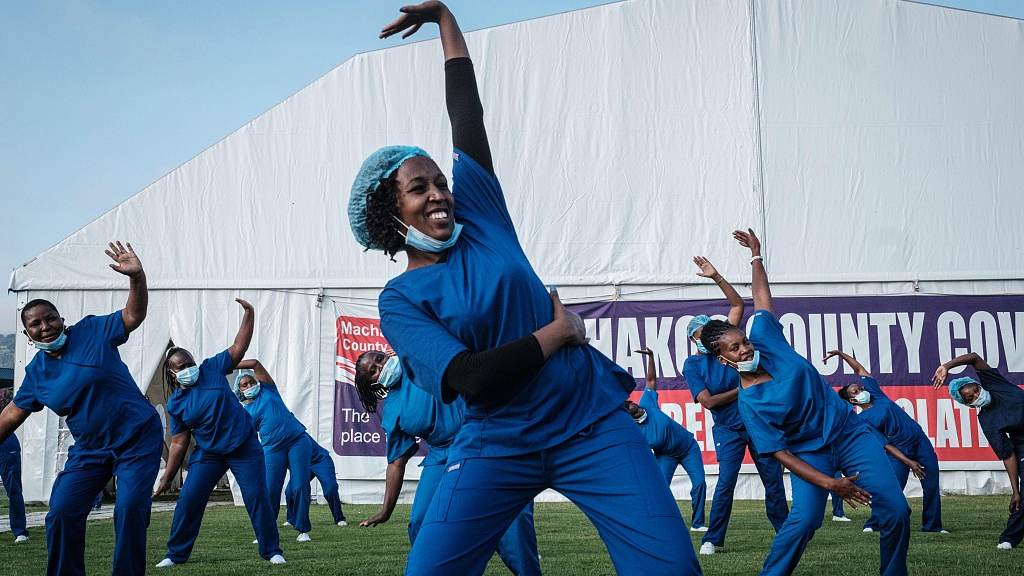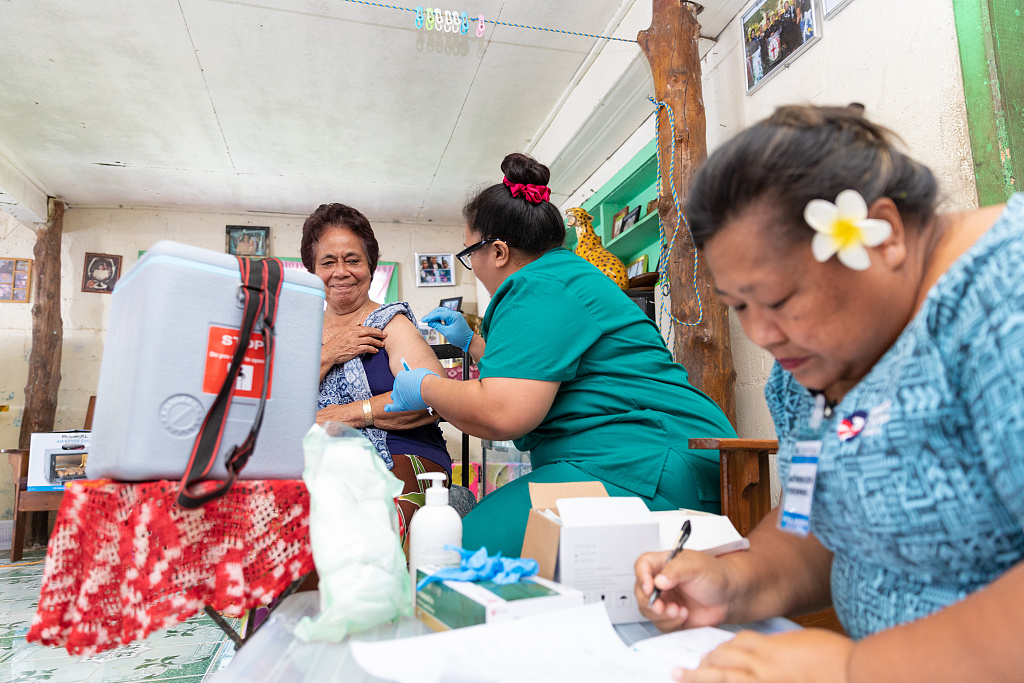
Health workers attend a dance session at Kenyatta stadium in Machakos, Kenya, as a part of the celebration of 2020, the International Year of the Nurse and the Midwife, June 19, 2020. /CFP
Health workers attend a dance session at Kenyatta stadium in Machakos, Kenya, as a part of the celebration of 2020, the International Year of the Nurse and the Midwife, June 19, 2020. /CFP
Editor's note: Lennie Bazira is the Policy Director of the Community Health Impact Coalition. Prossy Muyingo is a community health worker in Uganda and was named a 2023 Heroine of Health by Women in Global Health. The article reflects the authors' opinions and not necessarily the views of CGTN.
At least six million women worldwide provide unpaid or grossly underpaid labor in community-health centers, often in low- and middle-income countries (LMICs). Many work as community-health workers (CHWs). Though these are skilled jobs that should be salaried, only 34 countries offer CHWs accreditation, training, and salaries, leaving the majority exploited and therefore less effective for their patients. If we are serious about making "health for all" a global priority, this must change.
CHWs are crucial to strengthening health systems at the national level: they have been proven to improve maternal- and child-health services, expand access to family planning, and support prevention and care for both non-transmissible and infectious diseases. Deploying CHWs who consistently provide just 30 life-saving health services in countries with the highest disease burden would save as many as 6.9 million lives annually and reduce child mortality by almost half. Moreover, the COVID-19 pandemic demonstrated how resilient community-health programs can provide essential services even in the face of great adversity.
But such programs will reach their full potential only with service design that adheres to evidence-based best practices. That means treating CHWs as professionals who require training, fair pay, and safe working conditions. When used as a stopgap solution or a source of cheap labor, CHWs are less effective than their well-resourced counterparts.
In Africa, up to 85 percent of CHWs are unpaid, and, worldwide, CHWs' essential medicines are out of stock one-third of the time. In Uganda, our home country, there is a shortage of health-care workers, so CHWs have stepped up to fill the gap. Though these workers provide vital services to their communities, performing many of the same tasks as their salaried supervisors, they often receive little to no pay.
Why are CHWs, who are often women of color, expected to work and save lives without recognition or remuneration? It is clear that this is also a gender-rights issue. Patriarchal norms and power dynamics condition women to accept no or low wages for what should clearly be paid work. For example, women from low-income households and with low levels of education often view this type of unpaid work as an opportunity that might lead to paid work or an asset like a mobile phone or bicycle. Unpaid work in health care can also bring women social recognition. In many contexts, it is seen as honorable work that families will approve of for a woman. As a result, CHWs tend to juggle these positions with piecemeal paid jobs and family responsibilities.

Health workers roll out a COVID-19 vaccination campaign at the village of Tuanaimato in Apia, Samoa, September 23, 2021. /CFP
Health workers roll out a COVID-19 vaccination campaign at the village of Tuanaimato in Apia, Samoa, September 23, 2021. /CFP
These women face an unenviable dilemma. If they give up their work as CHWs to find full-time employment that can support them, who will provide much-needed health care for their communities? Backed into a corner by systemic inequalities and traditional gender roles, they often continue to overextend themselves, sacrificing stability, economic security, career progression, and their own well-being in the process.
To redress this entrenched social and economic injustice, professional CHWs must become the norm, not the exception. At minimum, CHWs must be accredited to ensure that certain standards are met; that they are paid a competitive wage, continuously trained and supported by a dedicated supervisor, and integrated into health systems, including primary health-care facilities and wider monitoring and evaluation systems. That way, they can be proactive in surveillance and see patients without point-of-care user fees. In short, CHWs must be salaried, skilled, supervised, and supplied.
After years of being marginalized and isolated, CHWs are now organizing and establishing in-country networks, largely using digital technology, to achieve these goals. More than 5,000 CHWs and aligned health organizations across 40 countries have come together via the Community Health Impact Coalition to translate shared research and advocacy work into policy change at the national level. Our shared mission is to ensure that all LMICs, including Uganda, adopt policies for professional CHWs.
The global community must decide whether it will fairly compensate those who, for decades, have propped up health systems in LMICs, or continue to exploit a largely female workforce. The moral choice is clear. Countries that professionalize CHWs and integrate them into a robust health infrastructure will be in the best position to make progress toward "health for all" – including for the women delivering the bulk of the care.
Copyright: Project Syndicate, 2023.
(If you want to contribute and have specific expertise, please contact us at opinions@cgtn.com. Follow @thouse_opinions on Twitter to discover the latest commentaries in the CGTN Opinion Section.)